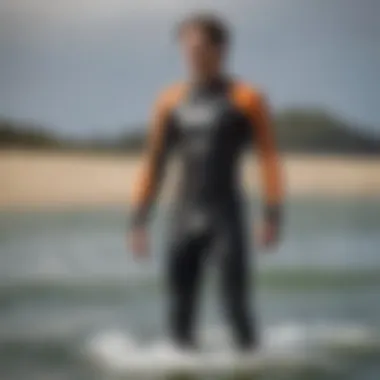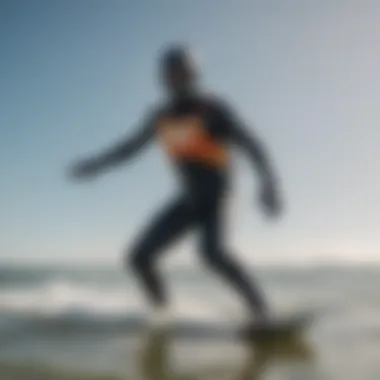Unlocking the Perfect Kiteboarding Wetsuit: A Comprehensive Guide


Equipment Reviews
Kites are essential equipment for kiteboarding enthusiasts. Choosing the right kite is crucial for optimizing performance on the water. When selecting a kite, factors such as size, shape, materials, and brands play a significant role. Kite shapes vary from bow, delta, hybrid, to foil kites, each offering unique advantages based on the rider's skill level and style. The materials used in kite construction, including ripstop nylon, Dacron, and Kevlar, impact durability and performance. Leading brands like Cabrinha, Naish, and North Kiteboarding are renowned for their quality and innovation in kite design.
Boards are another critical component of the kiteboarding setup. Two main types of boards are popular among riders: twintips and directional boards. Twintips, characterized by their symmetrical shape and ability to ride in both directions, are ideal for freestyle and casual cruising. In contrast, directional boards, featuring a pointed nose and tail, are designed for wave riding and higher speeds. Construction materials such as carbon fiber, wood, and foam core contribute to the board's flex, weight, and responsiveness. Choosing the right board depends on riding style, skill level, and water conditions.
Accessories play a vital role in ensuring a safe and enjoyable kiteboarding experience. Harnesses provide riders with support and leverage while controlling the kite. Lines connect the kite to the bar and come in various lengths to suit different riding styles. Pumps are necessary for inflating the kite quickly and efficiently. Safety gear like helmets, impact vests, and board leashes enhance protection on the water. Understanding the importance of each accessory and choosing quality gear is essential for elevating performance and safety while kiteboarding.
Introduction to Kiteboarding Wetsuits
Kiteboarding wetsuits are an indispensable element of the gear for any rider, playing a crucial role in enhancing performance, ensuring comfort, and providing protection from the elements. As kitesurfing involves being on the water for extended periods, a well-suited wetsuit is essential to maintain the rider's body temperature and keep them agile and comfortable throughout their session. This section delves into the key factors that make choosing the right kiteboarding wetsuit a critical decision for riders at any skill level.
Understanding the Importance of a Kiteboarding Wetsuit
Protection from Elements
Protecting the rider from elements such as cold water, wind, and UV rays is a primary function of a kiteboarding wetsuit. By utilizing advanced neoprene materials and sealed seams, these wetsuits act as a barrier against the harsh conditions encountered during kiteboarding sessions. The ability of the wetsuit to retain body heat and repel water ensures that riders can focus on their performance without being distracted by external factors. While providing necessary insulation, wetsuits also offer flexibility, allowing for unrestricted movement on the water.
Enhanced Performance
The design of kiteboarding wetsuits focuses on improving the rider's overall performance on the water. The streamlined fit reduces drag and improves hydrodynamics, enabling smoother movements and enhanced speed. By reducing resistance in the water, these wetsuits facilitate better control and maneuverability, essential for executing complex kiteboarding techniques. Additionally, the added buoyancy provided by wetsuits can assist less experienced riders in staying afloat and building confidence in challenging conditions.
Comfort and Mobility
Comfort and mobility are key considerations when selecting a kiteboarding wetsuit. A well-fitted wetsuit that allows for a full range of motion ensures that riders can move freely without restrictions. Features such as ergonomic paneling, seamless zones, and strategic reinforcement not only enhance comfort but also minimize chafing and irritation caused by constant movement. The ability to adapt to various body shapes and sizes further enhances the overall experience, making the wetsuit feel like a second skin in the water.
Key Factors to Consider
Thickness and Insulation
The thickness and insulation of a kiteboarding wetsuit play a vital role in determining its suitability for different water temperatures. Thicker wetsuits offer more warmth but may restrict movement, while thinner wetsuits provide greater flexibility but may require additional layering in colder conditions. Understanding the ideal thickness for the prevailing water temperatures can significantly impact the rider's comfort and performance on the water.
Material and Seam Construction
The quality of materials and seam construction directly influences the durability and functionality of a kiteboarding wetsuit. High-grade neoprene materials with reinforced seams not only enhance insulation and water resistance but also ensure long-term performance in challenging conditions. Choosing a wetsuit with superior material composition and robust seam sealing can prevent water ingress and prolong the life of the garment.


Fit and Sizing
Achieving the right fit and sizing is crucial for maximizing the benefits of a kiteboarding wetsuit. A snug yet comfortable fit prevents water flushing, maintains optimal insulation, and promotes agility on the water. Manufacturers often provide sizing guides to help riders select the appropriate wetsuit size based on their measurements. Ensuring a proper fit eliminates potential discomfort and ensures that the wetsuit performs as intended during kiteboarding sessions.
Types of Kiteboarding Wetsuits
In the realm of kiteboarding, the choice of wetsuit plays a vital role in determining the overall experience for riders. Kiteboarding wetsuits are not merely garments; they are essential gear that provides protection, enhances performance, and ensures comfort and mobility for the rider. Understanding the various types of kiteboarding wetsuits available is crucial for making an informed decision that aligns with individual needs and preferences.
Full Wetsuits
Features and Benefits
Full wetsuits are designed to cover the entire body, providing maximum coverage and insulation against cold waters. One of the key features of full wetsuits is their ability to keep the rider warm in challenging weather conditions, thereby extending the time spent on the water. The benefits of full wetsuits include superior thermal insulation, increased buoyancy, and protection against potential abrasions and injuries while kiteboarding. Their versatility makes them a popular choice for riders seeking comprehensive protection and comfort during their sessions.
Suitable Conditions
Full wetsuits are ideal for riders navigating cold waters or windy conditions where maintaining body heat is essential. The neoprene material and sealed seams of full wetsuits help to trap and retain body heat, ensuring that riders stay warm even in harsh environments. Additionally, the full coverage offered by these wetsuits makes them suitable for kiteboarding in varying water temperatures, safeguarding riders against chilly winds and potential hypothermia. While full wetsuits excel in colder conditions, they may limit mobility compared to shorter wetsuit options.
Shorty Wetsuits
Ideal Uses
Shorty wetsuits, characterized by their short sleeves and legs, are popular among riders looking for increased flexibility and reduced coverage. Their design allows for enhanced freedom of movement, making them suitable for warmer waters where full wetsuits may be unnecessary. Shorty wetsuits are preferred by riders engaging in kiteboarding activities during the hotter months or in tropical climates where a balance between insulation and breathability is crucial. Their versatility and lightweight construction make them the go-to choice for riders valuing agility and comfort.
Advantages and Limitations
The primary advantage of shorty wetsuits lies in their unmatched flexibility, enabling riders to perform agile maneuvers and tricks effortlessly. Additionally, their reduced coverage promotes better ventilation and prevents overheating during extended sessions in milder climates. However, the limited coverage of shorty wetsuits may not provide adequate protection in colder waters, limiting their usage to specific weather conditions. Riders must consider the trade-off between mobility and insulation when opting for shorty wetsuits.
Drysuits
Functionality
Drysuits offer a different approach to protection, focusing on waterproofing rather than insulation. The key functionality of drysuits lies in their ability to keep riders completely dry throughout their kiteboarding experience, regardless of external water conditions. By creating a watertight barrier between the rider and the elements, drysuits ensure optimal comfort and body temperature regulation. Their unique design minimizes water entry, providing a dry and comfortable ride even in extreme weather conditions.
When to Opt for a Drysuit


Riders should consider donning drysuits when facing extremely cold waters or prolonged exposure to wet environments where insulation alone may not suffice. Drysuits are a preferred choice for riders engaging in kiteboarding activities during winter or in icy waters, as they offer unparalleled protection against water intrusion. While drysuits excel in keeping riders dry, they may restrict mobility to some extent due to their bulkier construction. It is essential to assess the weather conditions and water temperature before opting for a drysuit to ensure comfort and safety during kiteboarding sessions.
Choosing the Right Kiteboarding Wetsuit
The section 'Choosing the Right Kiteboarding Wetsuit' is a pivotal segment within the broader context of this comprehensive guide. When it comes to kiteboarding, selecting the appropriate wetsuit is crucial for both comfort and performance on the water. A wetsuit acts as a protective barrier against the elements, ensuring that riders stay warm and dry throughout their sessions. Additionally, the right wetsuit can enhance a rider's agility and mobility, allowing for greater ease of movement while out on the waves. By carefully considering factors such as water temperature, riding style, and the duration of sessions, kiteboarders can make an informed choice that aligns with their specific needs and preferences.
Assessing Your Needs
Water Temperature
Water temperature is a key consideration when choosing a kiteboarding wetsuit. The thickness of the wetsuit's neoprene material plays a crucial role in regulating body temperature in varying water conditions. For colder waters, thicker neoprene provides better insulation, keeping riders warm and comfortable. However, in warmer climates, a thinner neoprene wetsuit allows for greater flexibility and mobility, ensuring that riders can move freely without feeling restricted. Understanding the relationship between water temperature and neoprene thickness is essential for selecting the most suitable wetsuit for optimal performance.
Riding Style
A rider's individual riding style also influences the choice of wetsuit. For those who prefer more aggressive and dynamic maneuvers, a wetsuit with increased flexibility and stretch characteristics is ideal. Such wetsuits enable riders to execute tricks and turns with precision and ease, improving overall performance on the water. On the other hand, riders who prioritize comfort and stability may opt for wetsuits with added buoyancy and support, enhancing their experience while kiteboarding.
Duration of Sessions
The duration of kiteboarding sessions directly impacts the level of comfort and protection required from a wetsuit. Long sessions demand wetsuits that offer both insulation and breathability to prevent overheating or discomfort. Breathable materials and strategic seam construction enhance airflow and ventilation within the wetsuit, keeping riders cool and dry even during extended periods on the water. By selecting a wetsuit that alignswith the anticipated duration of their sessions, riders can ensure consistent performance and comfort throughout their kiteboarding experiences.
Budget Considerations
Finding the Right Balance
Achieving a balance between quality and cost is essential when investing in a kiteboarding wetsuit. While budget constraints may influence the purchasing decision, compromising on quality can impact the wetsuit's performance and longevity. By prioritizing wetsuits that offer a balance of durability, functionality, and affordability, riders can make a smart investment that meets their needs without sacrificing on essential features or performance capabilities.
Investment in Quality
Investing in a high-quality wetsuit pays dividends in terms of performance, comfort, and durability. Quality wetsuits are constructed from advanced materials and feature innovative design elements that enhance overall functionality and user experience. While the initial cost may be higher, the long-term benefits of a quality wetsuit, such as extended longevity and improved performance, outweigh the upfront expenses. By viewing a high-quality wetsuit as a valuable investment, riders can elevate their kiteboarding experience and enjoy peace of mind knowing they have chosen a reliable and durable gear option.
Tips for Fitting and Maintenance
Ensuring Proper Fit
Ensuring a proper fit is paramount when selecting a kiteboarding wetsuit. A wetsuit that fits snugly but comfortably enhances thermal insulation and prevents water ingress, keeping riders warm and dry in varying conditions. Properly fitted wetsuits also prevent chafing and rubbing, ensuring optimal comfort during extended periods of use. Riders should carefully follow sizing guides provided by manufacturers and consider factors such as body shape and personal preferences to select wetsuits that offer the best fit for their individual needs.


Caring for Your Wetsuit
Proper maintenance is essential for maximizing the lifespan of a kiteboarding wetsuit. Regular rinsing with fresh water after each use helps remove salt, sand, and impurities that can degrade the wetsuit material over time. Drying the wetsuit in a shaded, well-ventilated area prevents premature wear and maintains the wetsuit's shape and integrity. Additionally, storing the wetsuit flat or hanging it on a wide, padded hanger prevents creases and damage to the neoprene. By incorporating simple yet effective care practices into their routine, riders can prolong the life of their wetsuit and ensure continued performance and comfort on the water.
Additional Considerations and Accessories
When it comes to kiteboarding, the significance of additional considerations and accessories cannot be overstated. These elements play a crucial role in enhancing the overall kiteboarding experience by providing added functionality and comfort. From choosing the right neoprene thickness for varying water temperatures to utilizing seasickness prevention techniques, every detail counts in ensuring a safe and enjoyable ride.
Neoprene Thickness Guide
Matching Thickness to Water Temperature
Matching the neoprene thickness to the water temperature is a critical aspect of selecting the perfect kiteboarding wetsuit. The thickness of the neoprene determines the level of insulation the wetsuit provides, thereby regulating body temperature during the ride. Riders must carefully consider the local water conditions and their personal tolerance to cold to match the neoprene thickness effectively. For colder waters, a thicker neoprene is recommended to prevent heat loss and maintain comfort, while in warmer climates, a thinner neoprene offers better flexibility without overheating.
Seasickness Prevention Techniques
Strategies for Mitigating Seasickness
Seasickness can be a common challenge for kiteboarders, especially in choppy waters or windy conditions. Implementing strategies to mitigate seasickness is crucial for a smooth and enjoyable kiteboarding session. Techniques such as choosing calmer riding locations, keeping a steady gaze on the horizon, and staying hydrated can help reduce the symptoms of seasickness. Additionally, using specialized wristbands or medication under medical supervision can further alleviate discomfort and allow riders to focus on their performance rather than feeling unwell.
Wetsuit Accessories
Gloves and Booties
Gloves and booties serve as essential wetsuit accessories for kiteboarders, offering protection and enhancing grip during ride sessions. These accessories provide added warmth and prevent abrasions or injuries from sharp objects in the water. While gloves ensure a firm hold on the kite bar and protect hands from wind chill, booties safeguard feet from cold temperatures and potential cuts or bruises. However, it is essential to find the right fit to maintain dexterity and comfort while kiteboarding.
Hoods and Rash Guards
Hoods and rash guards play a vital role in providing additional insulation and protection for kiteboarders. Hoods shield the head and ears from cold winds and water exposure, maintaining body heat and preventing discomfort. On the other hand, rash guards offer sun protection and minimize chafing from harnesses or wetsuit edges. Incorporating hoods and rash guards into kiteboarding gear enhances the overall riding experience by ensuring optimal comfort and safety.
Conclusion:
In wrapping up this comprehensive guide on selecting the perfect kiteboarding wetsuit, it is crucial to reinforce the significance of making an informed choice when it comes to your gear. The conclusion segment serves as the culmination of all the key insights provided throughout this article, emphasizing the vital role a wetsuit plays in enhancing a kiteboarding experience. From prioritizing comfort and functionality to investing in quality gear, each decision made impacts the rider's performance and safety on the water. By understanding the importance of selecting the right wetsuit, kiters can optimize their time on the waves and ensure they are well-equipped for varying conditions.
Final Thoughts on Selecting a Kiteboarding Wetsuit:
Prioritizing Comfort and Functionality:
Delving into the realm of prioritizing comfort and functionality in a kiteboarding wetsuit unveils a pivotal aspect crucial for riders of all levels. A wetsuit that prioritizes comfort ensures that the rider can focus solely on their performance without distractions. The functionality aspect goes hand in hand, as a well-designed wetsuit caters to the specific needs of a kiteboarder, offering freedom of movement and protection against the elements. The unique feature of comfort-focused wetsuits lies in their ergonomic design, tailor-made to enhance the rider's experience. While they may come at a premium, the advantages of investing in such a wetsuit are clear in the extended durability, increased buoyancy, and overall comfort they provide, making them a top choice for enthusiasts looking to elevate their performance.
Investing in Quality Gear:
Discussing the role of investing in quality gear sheds light on the long-term benefits and implications of this decision on a kitesurfer's journey. Opting for high-quality gear ensures reliability, durability, and enhanced performance in the long run. Quality gear not only withstands the rigors of kiteboarding sessions but also offers advanced features and materials that contribute to a better overall experience. The unique feature of quality gear lies in its attention to detail, precision engineering, and adherence to industry standards, which guarantee optimal performance and safety. While the initial investment may be higher, the long-term advantages outweigh the costs, as quality gear can last multiple seasons, providing consistent performance and peace of mind for riders seeking nothing but the best.







